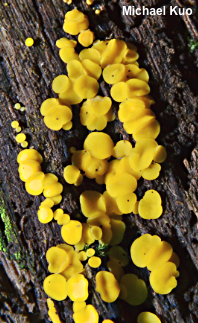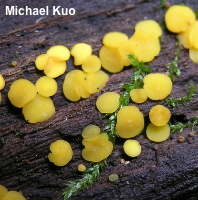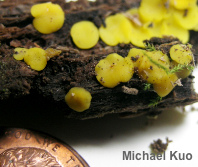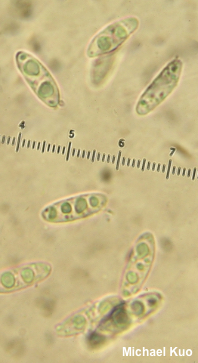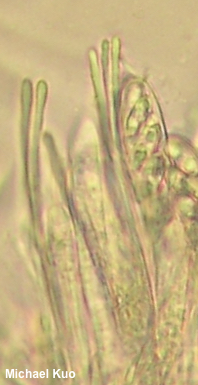| Major Groups > Cup Fungi > Bisporella citrina |

|
Bisporella citrina [ Ascomycota > Helotiales > Helotiaceae > Bisporella ... ] by Michael Kuo My optometrist tells me that "at about 40" is when men can expect to start peering over the tops of their glasses to see tiny things (he says that women, in one of the few cases where they get a raw deal in comparison to men, reach this stage in their early thirties). Well, Bisporella citrina is decidedly one of those tiny things requiring an OMHT (Old Man Head Tilt) to bring into focus, if one has crossed my optometrist's line in the sand; it has a maximum cap size of about four millimeters. For those young enough to examine the mushroom casually, the defining features are the diminutive size, the bright yellow color, and the habitat: densely gregarious on decaying wood. Microscopic features should be verified, however, if your identification effort is more than casual (see the details below). The mushroom is widely distributed and common but often (obviously) overlooked. There are many look-alike species. Bisporella subpallida and Bisporella sulfurina are smaller, believe it or not, maxing out at 1.5 mm; the former has smaller spores, and the latter has much narrower spores. Hymenoscyphus calyculus is also similar, but has a more well developed stem and fruits on sticks and twigs, rather than logs or stumps. Helotium citrinum, Calycina citrina, and Calycella citrina are synonyms. Description: Ecology: Saprobic on decaying logs and stumps of hardwoods and conifers; growing gregariously (often densely so) or in clusters; summer and fall (over winter in warmer areas); originally described from Europe and widely distributed across the globe; reported from all continents except Africa. The described and illustrated collections are from Illinois. Fruiting Body: 1–4 mm across; cuplike, becoming disc-shaped; with or without a tiny, tapering pseudostem; moist when fresh; upper surface bald, banana yellow; undersurface similar, or slightly paler; dried herbarium specimens orange. Odor: Not distinctive. Microscopic Features: Spores 12–16 x 3.5–5 µm; elongated-ellipsoid; smooth; sometimes becoming 1–2-septate; often biguttulate; hyaline in KOH. Asci 120–175 x 5 –8 µm; 8-spored; tips weakly amyloid or inamyloid. Paraphyses 150–180 x 1.5–2 µm; filiform; apices subclavate or merely rounded; smooth; hyaline in KOH; often numerous and packed quite tightly together. REFERENCES: (Batsch, 1789) Korf & S. E. Carpenter, 1974. (Fries, 1822; Saccardo, 1889; Dennis, 1968; Phillips, 1981; Breitenbach & Kränzlin, 1984; Phillips, 1991/2005; Schalkwijk-Barendsen, 1991; Lincoff, 1992; Horn, Kay & Abel, 1993; Barron, 1999; McNeil, 2006; Wang et al., 2006; Méndez-Mayboca et al., 2007; Bougher, 2009; Trudell & Ammirati, 2009; Raymundo et al., 2012; Beug et al., 2014; Kuo & Methven, 2014; Evenson, 2015; Baroni, 2017; Woehrel & Light, 2017; Elliott & Stephenson, 2018; Læssøe & Petersen, 2019; MacKinnon & Luther, 2021; McKnight et al., 2021.) Herb. Kuo 10280704, 10201301, 10301501. This site contains no information about the edibility or toxicity of mushrooms. |
© MushroomExpert.Com |
|
Cite this page as: Kuo, M. (2021, September). Bisporella citrina. Retrieved from the MushroomExpert.Com Web site: http://www.mushroomexpert.com/bisporella_citrina.html |
